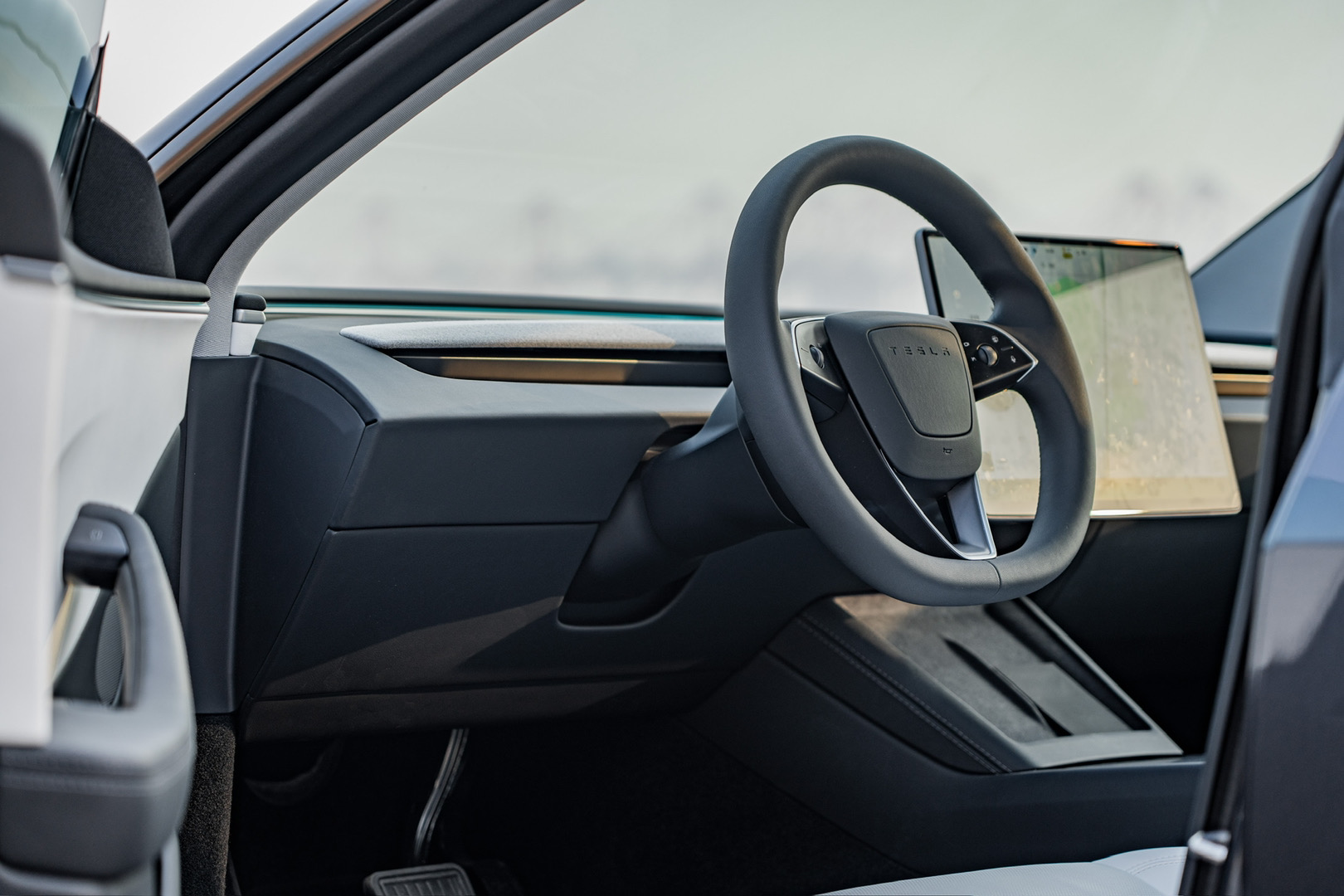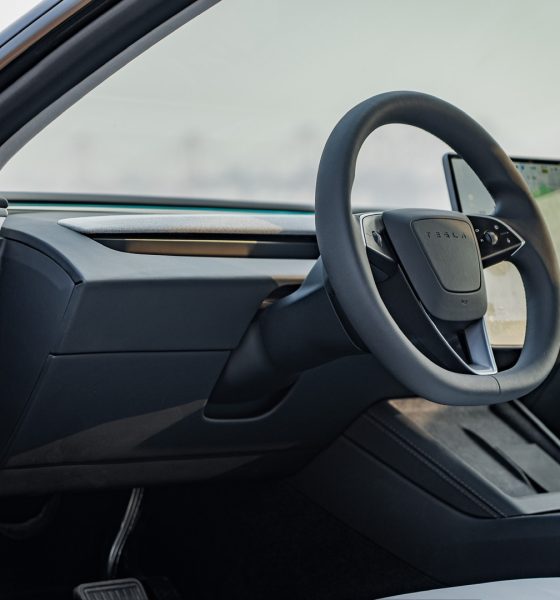

News
Tesla update 2024.26 introduces Parental Controls with “Night Curfew,” speed limits, and more
Tesla is reportedly rolling out software update 2024.26 to its employees, and as per observations from the electric vehicle community, this particular update seems to include a number of interesting features. Most notable is Parental Controls, which arguably make Teslas the best vehicle for young drivers.
As per Tesla software trackers like Tessie and NotATeslaApp, update 2024.26 is currently rolling out to company employees. Provided that the update’s rollout to employees is successful, 2024.26 would likely be released to the company’s greater fleet of vehicles soon.
A number of features are quite notable in Tesla’s update 2024.26. Parental Controls, for one, include a “Night Curfew” feature that allows parents to receive notifications to their Tesla App when the vehicle is driven past a set curfew. It also allows users to set speed limits, set acceleration restrictions, and activate safety features. Tesla describes its new Parental Control features in 2024.26’s release notes.
“You can now enable Parental Controls with a PIN on your vehicle. Set a maximum speed limit and limit acceleration to Chill. Turn on safety features, such as Speed Limit Warning, Automatic Emergency Braking, and Forward Collision Warning. Configure Night Curfew to receive notifications through your Tesla mobile app when the vehicle is driven past curfew.
“Enable Parental Controls from the vehicle or the Tesla mobile app. Navigate to Controls > Safety > Parental Controls. Follow the instructions on screen and provide a PIN. Drivers can’t disable the controls or change the settings without re-entering the PIN.”
??? Tesla 2024.26 software update has been detected, with a lot of awesome new features!!
✅ YouTube Music
✅ Amazon Music
✅ Parental Control (set maximum speed and acceleration limits, turn on safety features, and configure Night Curfew to get notifications when the vehicle… pic.twitter.com/w9PJyCQetj— Tesla Newswire (@TeslaNewswire) July 3, 2024
While Teslas have long been shipped with Valet Mode, which restricts a car’s speed and acceleration and disables Autopilot and Full Self-Driving (FSD), owners have long requested the EV maker to specifically release a “Teen Driver Mode” of sorts. Back in May, it seemed that the Tesla owners’ requests were being heard, with noted Tesla hacker @greentheonly stating that “restricted” driver profiles seem to be coming in a future update. This update appears to be 2024.26.
Apart from Parental Controls, Tesla’s software update 2024.26 also includes a number of novel features that would most likely be appreciated by electric vehicle owners. Following are the other features that were included in software update 2024.26.
YouTube Music
Listen to over 100 million songs with YouTube Music Premium. Access your Library to see all of your liked and added songs, playlists you created and artists and podcasts you subscribed to.
Requires Premium Connectivity or an active WiFi connection.
Amazon Music
Prime members get access to over 100 million songs in shuffle mode, All-Access playlists, plus the largest catalog of top ad-free podcasts. Upgrade to Amazon Music Unlimited for full, on-demand access.
Requires Premium Connectivity or an active WiFi connection.
Navigate to Sub-Destinations
Now when you enter a navigation destination you can select a sub-destination (such as a specific terminal at the airport) to get more accurate routing details.
Weather Forecast and Air Quality
Your vehicle status bar now shows the local weather conditions alongside the temperature. When air quality is poor, your vehicle also shows an AQI symbol and index value.
Tap the temperature on your touchscreen to see details about your local weather forecast, such as the weather condition, highs and lows of the day, and the chance of rain. Requires Premium Connectivity.
Schedule Charge and Preconditioning
From the redesigned menu or the Tesla mobile app, schedule charging or preconditioning for your vehicle. You can select a location, schedule a one-off, repeat specific times or days of the week, and also control when charging starts and stops.
To schedule your charge and precondition, tap Controls > Schedule.
Other Updates
- The Battle of Polytopia – ∑∫ỹriȱŋ ₼idŋighţ Skin Update – Create graves, build crypts, and summon demons from the graves in the dark forests with the special ∑∫ỹriȱŋ ₼idŋighţ skin.
- Vampire Survivors – “Laborratory” Update – Discover the secrets to dark mysteries with a new character, power-up, achievements, stages, and weapons.
- A redesigned climate panel allows you to select your comfort settings with ease.
- When in Auto, the fan speed may now automatically lower to reduce the sound of ambient noise during a phone call.
- Zoom meetings now default to full-screen when your car is in Park. You can also log in with QR code.
- TeslaMic is now supported in conjunction with availability in the Tesla store.
Don’t hesitate to contact us with news tips. Just send a message to simon@teslarati.com to give us a heads up.

Elon Musk
Elon Musk’s X will start using a Tesla-like software update strategy
The initiative seems designed to accelerate updates to the social media platform, while maintaining maximum transparency.

Elon Musk’s social media platform X will adopt a Tesla-esque approach to software updates for its algorithm.
The initiative seems designed to accelerate updates to the social media platform, while maintaining maximum transparency.
X’s updates to its updates
As per Musk in a post on X, the social media company will be making a new algorithm to determine what organic and advertising posts are recommended to users. These updates would then be repeated every four weeks.
“We will make the new 𝕏 algorithm, including all code used to determine what organic and advertising posts are recommended to users, open source in 7 days. This will be repeated every 4 weeks, with comprehensive developer notes, to help you understand what changed,” Musk wrote in his post.
The initiative somewhat mirrors Tesla’s over-the-air update model, where vehicle software is regularly refined and pushed to users with detailed release notes. This should allow users to better understand the details of X’s every update and foster a healthy feedback loop for the social media platform.
xAI and X
X, formerly Twitter, has been acquired by Elon Musk’s artificial intelligence startup, xAI last year. Since then, xAI has seen a rapid rise in valuation. Following the company’s the company’s upsized $20 billion Series E funding round, estimates now suggest that xAI is worth tens about $230 to $235 billion. That’s several times larger than Tesla when Elon Musk received his controversial 2018 CEO Performance Award.
As per xAI, the Series E funding round attracted a diverse group of investors, including Valor Equity Partners, Stepstone Group, Fidelity Management & Research Company, Qatar Investment Authority, MGX, and Baron Capital Group, among others. Strategic partners NVIDIA and Cisco Investments also continued support for building the world’s largest GPU clusters.
News
Tesla FSD Supervised wins MotorTrend’s Best Driver Assistance Award
The decision marks a notable reversal for the publication from prior years, with judges citing major real-world improvements that pushed Tesla’s latest FSD software ahead of every competing ADAS system.

Tesla’s Full Self-Driving (Supervised) system has been named the best driver-assistance technology on the market, earning top honors at the 2026 MotorTrend Best Tech Awards.
The decision marks a notable reversal for the publication from prior years, with judges citing major real-world improvements that pushed Tesla’s latest FSD software ahead of every competing ADAS system. And it wasn’t even close.
MotorTrend reverses course
MotorTrend awarded Tesla FSD (Supervised) its 2026 Best Tech Driver Assistance title after extensive testing of the latest v14 software. The publication acknowledged that it had previously criticized earlier versions of FSD for erratic behavior and near-miss incidents, ultimately favoring rivals such as GM’s Super Cruise in earlier evaluations.
According to MotorTrend, the newest iteration of FSD resolved many of those shortcomings. Testers said v14 showed far smoother behavior in complex urban scenarios, including unprotected left turns, traffic circles, emergency vehicles, and dense city streets. While the system still requires constant driver supervision, judges concluded that no other advanced driver-assistance system currently matches its breadth of capability.
Unlike rival systems that rely on combinations of cameras, radar, lidar, and mapped highways, Tesla’s FSD operates using a camera-only approach and is capable of driving on city streets, rural roads, and freeways. MotorTrend stated that pure utility, the ability to handle nearly all road types, ultimately separated FSD from competitors like Ford BlueCruise, GM Super Cruise, and BMW’s Highway Assistant.
High cost and high capability
MotorTrend also addressed FSD’s pricing, which remains significantly higher than rival systems. Tesla currently charges $8,000 for a one-time purchase or $99 per month for a subscription, compared with far lower upfront and subscription costs from other automakers. The publication noted that the premium is justified given FSD’s unmatched scope and continuous software evolution.
Safety remained a central focus of the evaluation. While testers reported collision-free operation over thousands of miles, they noted ongoing concerns around FSD’s configurable driving modes, including options that allow aggressive driving and speeds beyond posted limits. MotorTrend emphasized that, like all Level 2 systems, FSD still depends on a fully attentive human driver at all times.
Despite those caveats, the publication concluded that Tesla’s rapid software progress fundamentally reshaped the competitive landscape. For drivers seeking the most capable hands-on driver-assistance system available today, MotorTrend concluded Tesla FSD (Supervised) now stands alone at the top.
News
Elon Musk’s Grokipedia surges to 5.6M articles, almost 79% of English Wikipedia
The explosive growth marks a major milestone for the AI-powered online encyclopedia, which was launched by Elon Musk’s xAI just months ago.

Elon Musk’s Grokipedia has grown to an impressive 5,615,201 articles as of today, closing in on 79% of the English Wikipedia’s current total of 7,119,376 articles.
The explosive growth marks a major milestone for the AI-powered online encyclopedia, which was launched by Elon Musk’s xAI just months ago. Needless to say, it would only be a matter of time before Grokipedia exceeds English Wikipedia in sheer volume.
Grokipedia’s rapid growth
xAI’s vision for Grokipedia emphasizes neutrality, while Grok’s reasoning capabilities allow for fast drafting and fact-checking. When Elon Musk announced the initiative in late September 2025, he noted that Grokipedia would be an improvement to Wikipedia because it would be designed to avoid bias.
At the time, Musk noted that Grokipedia “is a necessary step towards the xAI goal of understanding the Universe.”
Grokipedia was launched in late October, and while xAI was careful to list it only as Version 0.1 at the time, the online encyclopedia immediately earned praise. Wikipedia co-founder Larry Sanger highlighted the project’s innovative approach, noting how it leverages AI to fill knowledge gaps and enable rapid updates. Netizens also observed how Grokipedia tends to present articles in a more objective manner compared to Wikipedia, which is edited by humans.
Elon Musk’s ambitious plans
With 5,615,201 total articles, Grokipedia has now grown to almost 79% of English Wikipedia’s article base. This is incredibly quick, though Grokipedia remains text-only for now. xAI, for its part, has now updated the online encyclopedia’s iteration to v0.2.
Elon Musk has shared bold ideas for Grokipedia, including sending a record of the entire knowledge base to space as part of xAI’s mission to preserve and expand human understanding. At some point, Musk stated that Grokipedia will be renamed to Encyclopedia Galactica, and it will be sent to the cosmos.
“When Grokipedia is good enough (long way to go), we will change the name to Encyclopedia Galactica. It will be an open source distillation of all knowledge, including audio, images and video. Join xAI to help build the sci-fi version of the Library of Alexandria!” Musk wrote, adding in a later post that “Copies will be etched in stone and sent to the Moon, Mars and beyond. This time, it will not be lost.”








